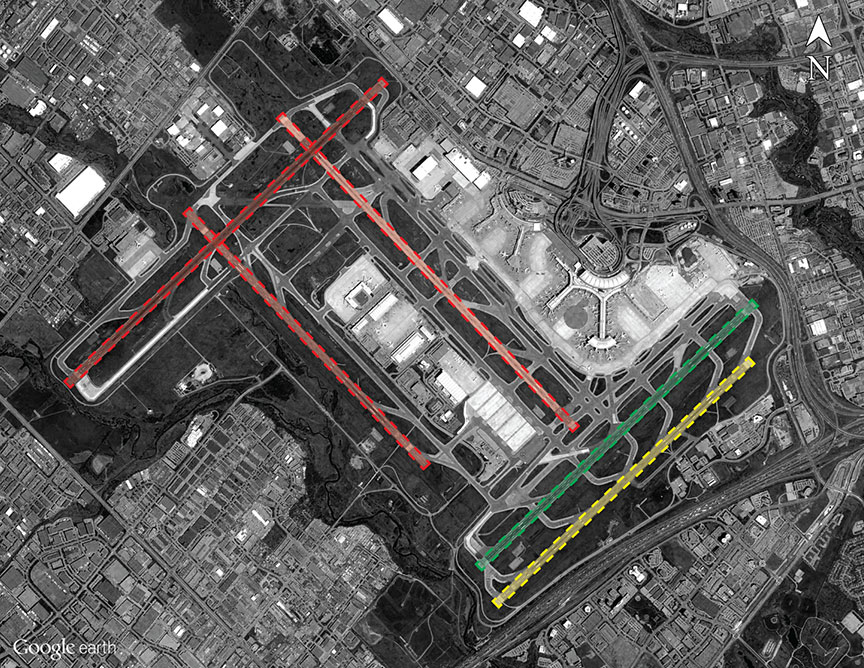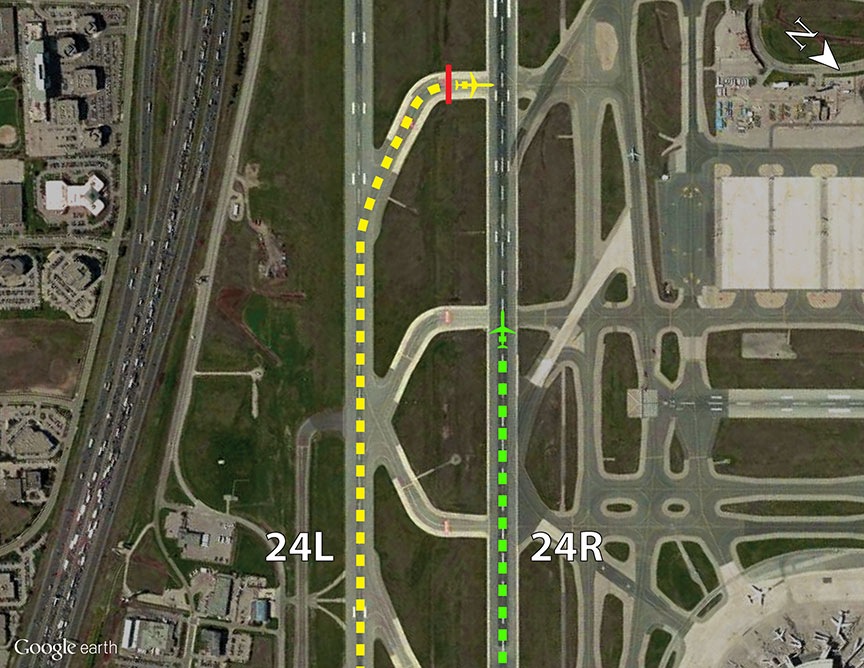Associated links (A17O0038)
Kathy Fox, TSB Chair
Ewan Tasker, Manager, Air Investigations Ontario Region
Toronto, Ontario
31 January 2019
Check against delivery.
Kathy Fox
Good morning.
Toronto's Lester B. Pearson International is the largest and busiest airport in Canada, with five runways handling over four hundred thousand flights each year.Footnote 1 With so many aircraft moving from place to place on the airport, there are sometimes conflicts, such as when an aircraft mistakenly intrudes, or “incurs” on a runway that is active.
Over the last few years across Canada, there were an average of 445 of these incursions each year—or just over one a day.
Although the vast majority of incursions posed little to no risk, the Transportation Safety Board of Canada has identified a troubling pattern at Pearson International—specifically at its two southern runways, known informally as the “South Complex,” which run parallel to each other and, during peak periods, are in use at the same time. Onscreen, these are green and yellow.
Today the TSB is releasing an investigation report into a series of 27 incursions at the South Complex between 2012 and 2017 when aircraft landed on one runway—the “outer” one—and then incurred on the other “inner” runway as they taxied back to the terminal. And because we found numerous similarities among these incursions, we are also making four recommendations: to NAV CANADA, to Transport Canada, to the US Federal Aviation Administration, and to the Greater Toronto Airports Authority. These recommendations address topics such as the phraseology used by air-traffic controllers, changes to flight crew Standard Operating Procedures — particularly regarding post-landing checklists—and even the design of the airport itself.
I'll talk more about those recommendations in a few moments. But first, I'll pose a question, one that goes to the heart of airport operations, human psychology, and airport geometry: “Why does this keep happening?” After all, Pearson airport traffic is tightly controlled and monitored. In addition to the specific instructions from air traffic controllers to stop, or “hold short” of the other runway, flight crews receive cues from multiple lights, warning signs, and painted lines on the ground.
How then, does a professional, highly trained, experienced flight crew miss all those cues? And why does it happen so frequently?
For the answer, I'll turn things over to the Investigator-in-charge, Mr. Ewan Tasker.
Ewan Tasker
Onscreen, you can see a diagram of the two runways that make up the South Complex. During busy periods, each of these can handle hundreds of takeoffs and landings each day. That means that once an aircraft lands it needs to move out of the way as soon as possible, because the next approaching aircraft might be only seconds behind. To do so quickly, an aircraft uses one of several “Rapid Exit Taxiways” located alongside the runway, shown onscreen in red.
Here's a video of what that looks like. (View the video)
For this short video, taken last year at the South Complex, we placed the camera at approximately eye level for a pilot of a smaller regional jet, which is the most common type of aircraft involved in the incursions.
You can see the aircraft leave the runway and taxi onto the rapid exit, you can see some of the lights, signs, and paint markings, and you can see the “hold-short” lines where the crew is supposed to stop.
Several characteristics of these rapid exits on the South Complex are different from almost every other major airport in North America. For example, the exits lead directly to the “inner” parallel runway, the hold-short lines are located immediately following a curve and, most notably, are farther away from the protected runway. These uncommon features mean that the hold-short lines are not where crews are expecting to see them, and, combined with crews who aren't familiar with the exits, and relatively fast regional jet taxi speeds, this reduces the chance that crews recognize the lines in time to stop before incurring on the runway.
But speed and the unusual placement of the cues are not the only reasons behind the frequent incursions. There is also the issue of distraction—distraction often created by the flight crews' own Standard Operating Procedures. For instance, it's normal for many crews to initiate their post-landing actions immediately after exiting the runway. But doing this can take their attention away from other more critical tasks—such as watching for that hold-short line. And simply telling flight crews to keep “heads-up” doesn't always work, either; faced with one procedure that says to be heads-up when leaving the runway, and another that says “complete your post-landing actions” at the same time … flight crews often opt for the actions, becoming distracted at the worst possible time.
I'll now turn back to TSB Chair Kathy Fox, to discuss how these problems need to be addressed.
Kathy Fox
All 27 of the incursions examined in this report involved flight crews who had been instructed to hold short, who had accurately read back that instruction, who understood they needed to stop, and who understood they were approaching an active runway. However, despite those factors, these flight crews did not recognize the visual cues that identified the runway holding position, and so they didn't stop as required—thereby risking a collision with another aircraft on the other runway.
Today the TSB is making four recommendations to address that risk.
The first is for air-traffic controllers, who were and are the last-line of defense in these situations. What we learned was that, sometimes when an incursion required controllers' to issue safety critical instructions to the second aircraft involved—one either departing or landing—those other flight crews did not always realize the order was being directed at them, or at least didn't realize the significance of what was being said. That's why we want NAV CANADA to modify the phraseology so it better captures crews' attention. This could include use of the word “immediately,” or even repeating the instruction. Such a change would bring the phraseology in line with international guidance, making it sufficiently compelling, particularly during periods when flight crews receiving the instruction have a high workload.
The next two recommendations—one aimed at Transport Canada, and the other at the US Federal Aviation Administration—would see flight crew Standard Operating Procedures amended so that post-landing checks are only begun after an aircraft has cleared all active runways. This would keep flight crews' attention focused outside the cockpit when approaching and crossing active runways, and reduce work-related distraction at critical moments.
Finally, we are recommending that the Greater Toronto Airports Authority make physical changes to the taxiway layout at Pearson International's South Complex. This could happen in a number of ways—for instance, changing the design and position of the rapid exit taxiways, creating a “perimeter taxiway” to go around the other active runway, or even constructing a separate intermediate taxiway between the two parallel runways. In fact, the TSB examined 130 airports worldwide, including the top 100 airports internationally and the top 60 airports in the United States by passenger volume, and Pearson International was the only one in North America that had sufficient space for an intermediate parallel taxiway between its parallel runways, but did not include one.
Ultimately, it's up to the GTAA to decide which physical changes are made. In the meantime, until those changes are made, we want to see further improvements to increase the visibility of these hold-short positions. Because clearly, more needs to be done—so that all flight crews see the cues and react as required. And until this happens, the TSB will continue to push for safer skies—and safer airports—for everyone.
Thank you.


